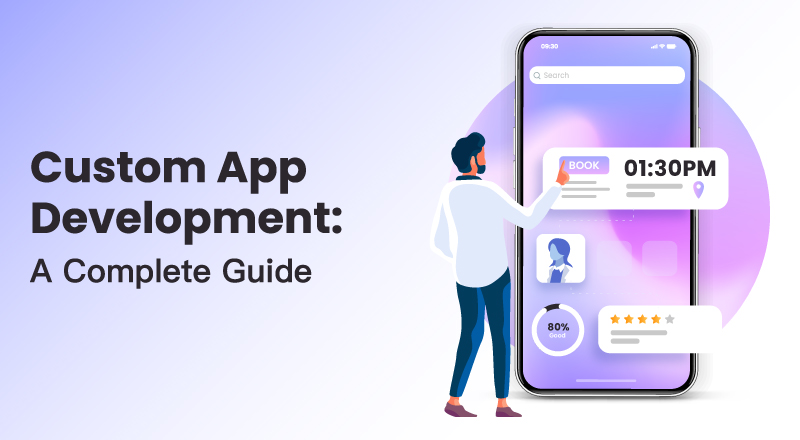In today’s society, when convenience is essential, on-demand applications have quickly taken on a crucial role in daily life. On-demand apps provide customers with unmatched efficiency and convenience for everything from scheduling services and managing delivery to ordering food and rides. Creating a unique on-demand app gives companies the chance to interact with consumers, improve efficiency, and gain a competitive advantage.
This guide covers everything you need to know about custom on-demand app development, including why it’s essential, how it works, and the best practices to ensure your app’s success.
What is Custom On-Demand App Development?
Custom on-demand app development is the process of developing applications that are specifically designed to provide users with services or goods at the precise moment they require them. Custom on-demand apps, as opposed to regular apps, are made to specifically address the demands of a company or sector. These applications enable real-time connections between users and services or providers, enabling companies to quickly and effectively address client needs.
Common Industries for On-Demand Apps:
- Food and Beverage (e.g., food delivery apps)
- Transportation (e.g., ride-hailing services)
- Healthcare (e.g., telemedicine or on-demand nursing)
- Retail and E-commerce (e.g., quick delivery for retail items)
- Logistics and Courier Services (e.g., last-mile delivery apps)
Why Custom On-Demand App Development is Essential for Modern Businesses
More than just a means of reaching consumers, personalized on-demand apps offer a platform that improves customer satisfaction, fosters brand loyalty, and propels company expansion. Businesses engage in custom on-demand app development for the following main reasons:
- Enhanced Customer Experience
Businesses can provide features that are tailored to their clients with a custom app, guaranteeing user friendliness, quick response times, and individualized attention. - Brand Differentiation
By displaying distinctive features, branding components, and cutting-edge functionality, a well-designed custom app helps a firm stand out from the competition. - Operational Efficiency
On-demand apps lower costs and enhance service delivery by streamlining procedures including scheduling, dispatching, inventory control, and customer communication. - Customer Insights and Analytics
Businesses may make data-driven decisions and continuously enhance their services by using the useful information that custom apps provide on customer behavior, preferences, and comments.
Key Features of a Custom On-Demand App
An on-demand app needs essential features that improve usability and convenience for users and service providers alike if it is to be successful. Below is a summary of key characteristics:
1. User Registration and Profiles
Make it simple for consumers to create individualized profiles and sign up using email addresses or social media accounts.
2. Service/Item Listings and Search
Users can browse and choose services or products with ease according to an easy-to-use catalog and search features.
3. Real-Time Tracking and Notifications
Users may view the whereabouts of their purchase or provider by using real-time tracking, which offers transparency. Throughout the procedure, push notifications keep them informed.
4. Multiple Payment Options
Providing a range of payment methods (cash, mobile wallets, credit cards, etc.) improves convenience and boosts conversions.
5. Reviews and Ratings
Allowing users to leave feedback fosters trust and helps improve service quality.
6. In-App Chat Support
Users are more satisfied when they can ask inquiries or get problems fixed quickly through real-time contact.
7. Admin Dashboard
An admin dashboard is essential for backend management in order to track orders, manage users, and learn more about the operation of the service.
8. Analytics and Reporting Tools
Businesses may analyze user engagement, track demand trends, and optimize operations with built-in analytics.
9. Security and Privacy Features
Building user trust requires putting reliable information encryption, authentication, and compliance procedures into place.
Step-by-Step Process to Develop a Custom On-Demand App
A methodical approach is necessary when creating custom on-demand software to make sure it satisfies user demands and corporate goals. Here is a detailed breakdown of the development process:
Step 1: Research and Planning
- Define the app’s purpose, target audience, and key features.
- Conduct market research to identify competitors and user preferences.
- Create a project roadmap with timelines, milestones, and a budget.
Step 2: Wireframing and Prototyping
- Develop wireframes to map out the app’s structure, layout, and navigation.
- Create a prototype to visualize the app’s functionality and get early feedback.
Step 3: Design and UI/UX Development
- Design an intuitive, user-friendly interface that aligns with your brand.
- Prioritize ease of navigation and ensure that the design is responsive across devices.
Step 4: Backend and Frontend Development
- Build the backend to manage data, user requests, and transactions securely.
- Develop the frontend, focusing on seamless interactions and responsive design.
- Integrate APIs for essential functionalities like real-time tracking, payments, and notifications.
Step 5: Testing and Quality Assurance
- Conduct comprehensive testing, including functional, usability, and performance tests.
- Address bugs and ensure compatibility across different devices and operating systems.
Step 6: Deployment and Launch
- Deploy the app on app stores, ensuring compliance with platform guidelines.
- Plan a marketing campaign to drive initial user adoption.
Step 7: Post-Launch Support and Updates
- Monitor app performance, gather user feedback, and update the app regularly.
- Add new features and improvements based on user needs and market trends.
Technology Stack for On-Demand App Development
Selecting the right tech stack ensures smooth performance, scalability, and security. Here’s a suggested tech stack:
- Frontend: React Native, Flutter, or Swift (iOS), Kotlin (Android)
- Backend: Node.js, Django, or Ruby on Rails
- Database: MongoDB, MySQL, or PostgreSQL
- Real-Time Tracking: Google Maps API, Mapbox
- Payment Gateways: Stripe, PayPal, Braintree
- Push Notifications: Firebase, OneSignal
- Cloud Services: AWS, Google Cloud, or Microsoft Azure
Cost Factors in Custom On-Demand App Development
The cost of developing a custom on-demand app depends on several factors, including:
- Complexity of Features
Advanced features like real-time tracking, multiple payment integrations, and in-app chat increase development costs. - Platform Choice
Developing for both iOS and Android is more costly than a single platform. - Design and UX Complexity
A unique, polished design with custom animations and branding may add to the overall cost. - Backend Infrastructure
Scalable backend infrastructure that supports real-time processing may require additional investment. - Location of Development Team
The hourly rate of developers varies significantly by region, impacting the total cost of the project.
A simple custom on-demand app may cost between $30,000 and $50,000, but complex apps with more features might cost over $100,000.
Tips for Success in Custom On-Demand App Development
Strategic planning and execution are necessary for creating a successful custom on-demand application. Here are a few points to remember:
1. Focus on User Experience (UX)
To keep users, make sure the app is quick, simple to use, and aesthetically pleasing.
2. Leverage Data Analytics
Utilize analytics to learn about user preferences, enhance performance, and roll out new features based on insights from data.
3. Implement Strong Security Measures
Make sure that user data is safeguarded by frequent updates, secure authentication, and encryption.
4. Build for Scalability
As the company expands, design the app to accommodate growing customer demand and additional offerings.
5. Market Effectively
Develop a pre-launch marketing plan to generate excitement and boost initial downloads.
Future Trends in On-Demand Apps
Long-term success in the on-demand sector depends on staying ahead of trends, which are always changing.
- Artificial Intelligence (AI): AI can enhance the user experience by offering personalized recommendations and predictive analytics.
- Augmented Reality (AR): AR features can enhance shopping experiences or allow users to visualize services.
- Voice Search and Commands: Voice-activated features make ordering or searching services more accessible.
- Sustainability: As consumers’ preferences for environmentally friendly solutions grow, integrating sustainability principles into logistics may offer value.
Conclusion
Developing personalized on-demand apps is a great way to interact with customers, improve business processes, and increase brand awareness. You can make an app that stands out in a crowded market by knowing the key features, picking the appropriate tech stack, and concentrating on the user experience.


